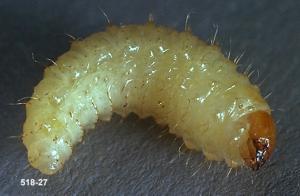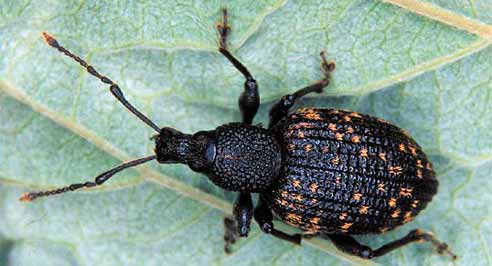By Greg Welfing
Pest Profile is a recurring feature in this magazine. Periodically we pick an agricultural pest to feature and learn more about its biology and control methods.
Black vine weevils, Otiorhynchus sulcatus are a very common pest of highbush blueberries. Black vine weevils are native to Europe and have been present in North America since the early 1900s. They are the most prevalent of all of the weevil species to attack highbush blueberries. There are other weevil species that also infest highbush blueberries, but we will focus on the black vine weevil (BVW) here. Black vine weevils are very widespread in the Fraser Valley. They have a myriad of host plants including many of the small fruit plants as well as many ornamentals.
Biology

Black vine weevils can overwinter as either larvae or as adults. There is one generation of BVW per year; however, different generations and life stages can overlap at the same time. BVW larvae will pupate and emerge from the soil as adults in late spring and begin feeding.
Egg laying can start to occur about 3 weeks after the adults emerge, and will continue through the summer. Egg laying stops in early fall (September). Eggs will hatch within 2-3 weeks and the larvae will begin feeding on the plant roots. This feeding can continue throughout the winter as long as the temperature allows.
All BVW adults are female. BVW adults do not have the ability to fly like many other beetle species; however, they are very strong walkers and can easily move between plants in a field. Adults are about 1.3 cm long, with a pronounced curved snout. They are usually black with a few yellow or orange spots. The larvae are legless, white with a brown head and C-shaped.
Damage

The adult BVW will crawl up the stem of the plant onto leaves at night. They will chew on the outside of the leaves leaving characteristic half circle notches in the leaves. In isolation, the feeding by the adult BVW would not cause the plant much harm; however, the real damage to the host plant is caused by the larvae.
The larvae spend their time within the rhizosphere (root zone) and feed on the smaller feeder roots and crown of the plant. This can lead to significant plant decline as it loses the ability to uptake water and nutrients. Also, the feeding of the larvae makes the roots of the blueberry susceptible to infection of root-rot-causing fungi. If left uncontrolled, this combination of factors will lead to serious plant decline or death within 2-4 years.
Management
As always, the key to successful insect management is good monitoring. One can monitor for adults during the day by looking for fresh notching on the leaves or by looking in the top layer of soil or leaf debris. The presence of the adults can be confirmed at nighttime while they are on the plant feeding.
There are two main strategies for controlling BVW. One of them is to target the adults while they are active/feeding, the other is to target the larvae in the soil. There are a few chemical products registered in Canada for use to control the adults. Timing of the insecticidal spray is critical since the adults do not all emerge at the same time. Spraying in the evening can also increase control since the adult BVW will be active at that time.
Another management option is the insecticidal fungi (Metarhizium spp.) that can infect the insect and control it when mixed into the soil. This method has shown great success in the nursery setting.
Entomopathogenic nematodes have also shown good control in certain conditions. The Heterorhabditis spp and Steinernema spp species of nematodes can attack the larval stage of the BVW and kill it. Since the target is the larval stage of the BVW, the nematodes must be applied to the soil, usually in the form of a directed drench spray in the fall.
Sources:
- http://www2.gov.bc.ca/assets/gov/farming-natural-resources-and-industry/agriculture-and-seafood/animal-and-crops/plant-health/phu-weevils-blueberry.pdf
- http://ento.psu.edu/extension/factsheets/black-vine-weevil
- http://productionguide.agrifoodbc.ca/guides/14/section/16/chapter/36
- https://pnwhandbooks.org/insect/small-fruit/blueberry/blueberry-root-weevil
- http://mint.ippc.orst.edu/blackvineid.htm
- http://web.forestry.ubc.ca/fetch21/Z-lab%20notes-folder/Insect%20pests%20of%20seedling%20in%20bc.pdf
- http://whatcom.wsu.edu/ipm/manual/blue/weevil.html
Get your FREE subscription to MODERN AG MAG!
[infobox title=’Greg Welfing’] Greg has an intense interest in biology and agricultural systems. Plant and insect dynamics have always been in passionate focus. Armed with a BSc degree and years of experience in agricultural research, monitoring, and technical sales, Greg brings a wealth of knowledge to our writing team.[/infobox]
Greg has an intense interest in biology and agricultural systems. Plant and insect dynamics have always been in passionate focus. Armed with a BSc degree and years of experience in agricultural research, monitoring, and technical sales, Greg brings a wealth of knowledge to our writing team.[/infobox]











